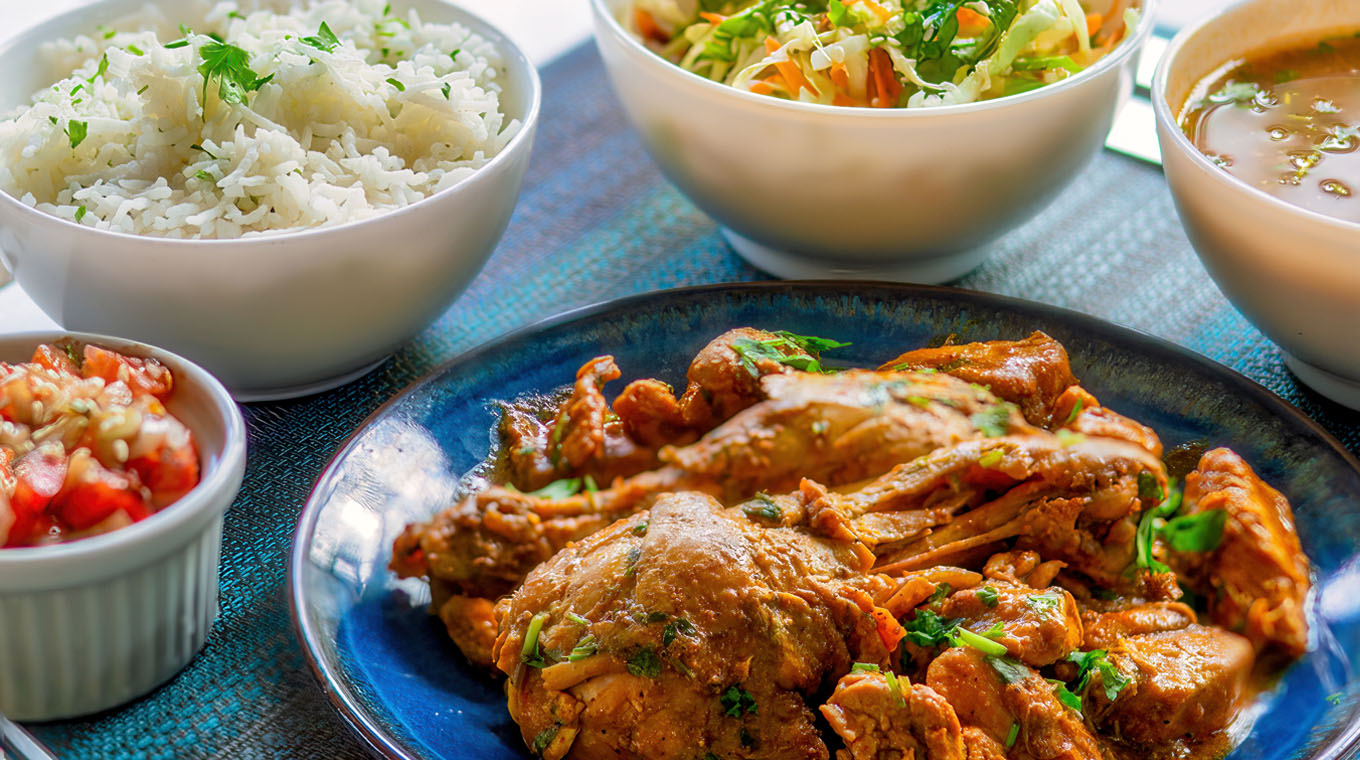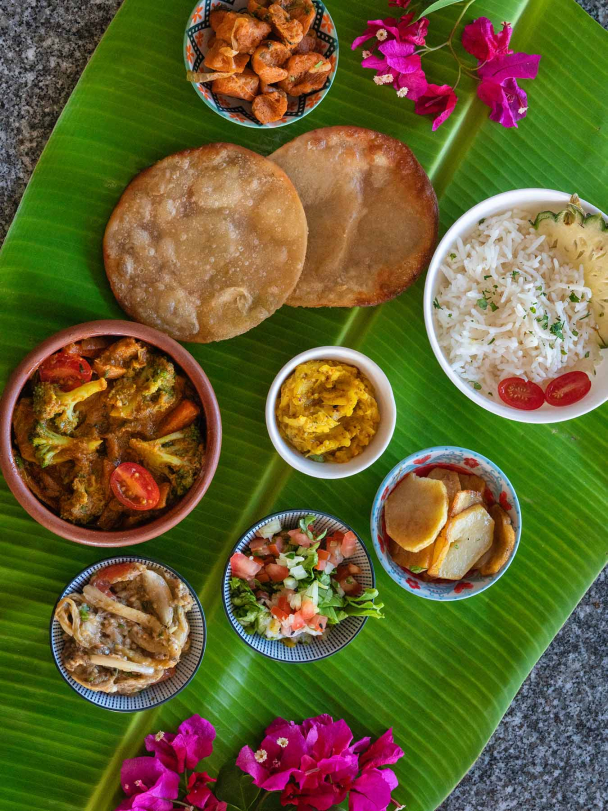Between turquoise lagoons, pristine beaches, and tropical forests, this little paradise in the Indian Ocean captivates as much by its laid-back lifestyle as by the richness of its culture.
Cosmopolitan and diverse, the Mauritian population reflects a complex history shaped by encounters, migrations, and shared experiences. This cultural blend is perfectly reflected on the plate.
Creole cuisine, with Indian, Chinese, African, and European influences: Mauritian gastronomy is a fabulous journey for the senses—generous and colorful.
Ready to savor the soul of Mauritius? Join us for a culinary exploration at the heart of a heritage as rich as it is authentic.

Curry, vindaye, salmi, dholl puri, mine frit… let’s dive into the flavors of Mauritian cuisine!
The origins and influences of mauritian gastronomy
Traditional Mauritian cuisine is a fusion of flavors, spices, and creativity. It truly reflects the island’s cultural diversity.
Over the centuries, Mauritius has been shaped by various waves of immigration and encounters between different peoples. Its history is marked by exchanges and influences from around the world.
The french Influence on mauritian gastronomy
From the 18th century onwards, the arrival of French colonists further transformed Mauritian gastronomy. The French introduced a wide variety of ingredients, spices, and cooking techniques. They brought with them their culinary culture. Many French dishes and desserts were incorporated into the local cuisine, giving rise to a unique blend of European and tropical flavors.
In the 19th century, the abolition of slavery also had a significant impact on Mauritian gastronomy. New workers arrived in Mauritius from India, China, and Africa to work on the island’s sugar plantations. These immigrants brought with them their culinary traditions, which gradually became integrated into an ever-evolving Mauritian cuisine.
The importance of indian Immigration
Indian immigration played a major role in the development of Mauritian gastronomy. The many Indian workers introduced new grains and spices that have left a lasting mark on local cuisine.
Dishes such as curry, dholl puri, and biryani have become essential elements of Mauritian cuisine, reflecting the importance of Indian immigration in Mauritian society.
Chinese, african, and creole Influences
The Chinese brought noodles, wok cooking, and a variety of condiments and sauces, which are now widely used in local cuisine. Popular dishes today in Mauritius, such as fried noodles (mine frit) and meat or fish dumplings, are perfect examples.
African and Malagasy communities contributed by introducing the use of cassava and taro.
Finally, the Creole population of Mauritius developed its own traditional cuisine full of diverse flavors by blending elements from these various culinary traditions.
What are the essential ingredients of mauritian cuisine?
Rich in flavors and colors, traditional Mauritian cuisine draws its origins from the influences of its Creole, Indian, European, Asian, and African communities. It perfectly reflects the diversity and harmony of these different cultures.
Some ingredients are essential staples in Mauritian culinary specialties—you’ll find them in most dishes! Among them are:
- Tomatoes, in several varieties
- Garlic and onions, present in almost every recipe
- Ginger, a testament to Indian and Asian influence
- Chili: whole, crushed, or powdered—you’ll find it in all forms to spice up your dishes and tease your taste buds
- Coriander (cotomili) and herbs in general
- Spices such as cloves, star anise, cinnamon, and turmeric
What Are the Culinary Specialties of Mauritius?
Mauritian street food
How could we begin our tour of Mauritian culinary specialties without starting with Mauritian street food?
Just wander through the streets of any town in Mauritius, and you’ll discover these typical local street food dishes:
- Dholl Puri is probably the most loved and widely eaten dish on the island, enjoyed by both tourists and locals alike. It’s a local creation and an authentic Mauritian specialty! These large flatbreads are made from chickpea flour and filled with curried yellow split peas, rougail, chatini, and a Rodrigues candied chili. An absolute must-try.
- Mauritian Dumplings: Originally from Asia, these dumplings can be found on every street corner in Mauritius, usually served with a hot broth. There are four varieties: fish dumplings, meat dumplings, sao-maï dumplings, and chouchou (chayote) dumplings, made from a local vegetable.
- “Cari Pom de Ter” Samosas: This is a vegetarian version of the typical Indian samosas. Highly appreciated by Mauritians, they are filled with a curried masala potato stuffing.
- “Gato Pima”: Another street food staple. These are small fried split pea balls, flavored with coriander and chili. Honestly, they’re a true delight.
- “Gato Arouille”: Also small fried balls, crispy on the outside and soft on the inside. They’re made from arouille, a small tuber also known as taro.
Typical mauritian dishes
Discover 8 classic recipes from Mauritian cuisine!
- Cari (Curry): Made with meat, chicken, or fish and cooked in a spicy sauce based on curry and chili, this dish is inspired by Indian curry recipes and is widely enjoyed by the island’s inhabitants, regardless of their background. It can be served with rice or bread.
- Fish Vindaye: Also originating from India, vindaye is fried in oil before being mixed with spices, onions, garlic, chili, and vinegar to enhance its flavors. It’s often served with bread or rice.
- Daube: Made with wild boar or chicken, this dish reflects the French influence on Mauritian gastronomy.
- Mine Frit: A Mauritian take on Chinese stir-fried noodles, typically cooked with vegetables, meat, or seafood. It’s seasoned with garlic or chili sauce.
- Fish Rougail: A typically Creole dish, rougail mainly consists of a sauce made from tomato, garlic, ginger, onions, chili, and spices. Salted fish, known locally as “sounouk,” is added. It’s served with white rice and lentils.
- Biryani (Briani): Originating from Muslim cuisine, this dish features saffron rice mixed with lamb, chicken, or fish, combined with spices and vegetables. There is also a vegetarian version.
- Chatini (Chutney): “Chatini” is a Creole Mauritian word equivalent to the English “chutney.” It is a raw, spicy, and tangy condiment made from various chopped fruits and vegetables such as tomato, mango, cucumber, and more. It’s often served as an accompaniment to rice dishes.
- Grilled Seafood: Thanks to the abundance of fresh fish and seafood in the lagoon surrounding the island, grilled seafood dishes are very popular and always delicious.
Mauritian desserts
In Mauritius, desserts are just as rich and varied: Indian pastries, sweet potato cakes, coconut cakes, and “poudine mais” (corn pudding) are perfect examples.
Drinks are not to be forgotten either: you can enjoy lassi (a frozen yogurt drink of Indian origin) and alouda, a sweet, milky beverage made with agar-agar, flavored with almond or vanilla.
Finally, to savor at the end of a meal, Mauritian rum is renowned worldwide for its complex taste and unique character.
In summary, the richness of Mauritian gastronomy lies in its diversity, authentic flavors, and unique cultural heritage, making every meal a true culinary adventure.
Discover the Best of Mauritian Cuisine at Station A
Station A is the restaurant of Domaine d’Anbalaba, the new lifestyle hub in the south of Mauritius.
Designed for the permanent and seasonal residents of the estate, locals, and visiting guests, our restaurant perfectly embodies the Mauritian art of living. Set in a large Creole house, Station A is much more than just a dining spot: it’s a meeting place, a moment of sharing, a delicious pause.
On the veranda, overlooking the lagoon, let yourself be tempted by a gourmet break and discover a refreshed Mauritian cuisine, full of freshness, character, and vibrant colors.

